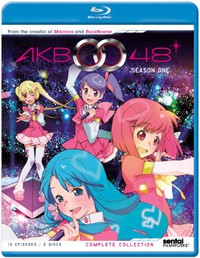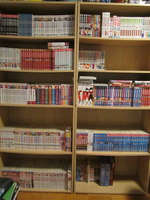Shelf Life
Dead Girl Walking
by Bamboo Dong,

Sankarea: Undying Love Complete Collection BD
Rental Shelf
AKB0048 Season 1 Complete Collection BD
Sakura Wars - The Movie BD+DVD
Perishable
Nothing this week
Alright, welcome to Shelf Life.
 As a casual AKB48 fan, it's hard not to automatically get sucked into a show that opens with cute girls dancing to "Aitakatta," arguably one of AKB48's catchiest singles of all time. Next to "River," of course, but that shows up later in the season, along with a handful of other AKB48 staples. Say what you will about the AKB0048 anime and how silly the premise is, or how the story takes forever to get anywhere—the music is stupid catchy, and that's almost reason enough to watch this series.
As a casual AKB48 fan, it's hard not to automatically get sucked into a show that opens with cute girls dancing to "Aitakatta," arguably one of AKB48's catchiest singles of all time. Next to "River," of course, but that shows up later in the season, along with a handful of other AKB48 staples. Say what you will about the AKB0048 anime and how silly the premise is, or how the story takes forever to get anywhere—the music is stupid catchy, and that's almost reason enough to watch this series.And why wouldn't it be? From its inception to its execution, AKB0048 is a vanity project for the massive entertainment juggernaut that is AKB48 and its sister groups. Its story relies on the premise that in the not-too-distant future, humanity occupies several planets, some of which have banned music and art. That itself is not too far-fetched, considering less than half a century ago, Western classical music was banned in Cultural Revolution-era China, and some countries still selectively ban certain artists or songs. The implication in AKB0048, though, is that “AKB0048” will be the wind of hope and optimism that revolutionizes each planet. Literally, on planets that have banned all forms of entertainment, the signs that are displayed around town actually say, “No Idols,” as though somehow idol music were the sole vehicle for music entertainment anywhere.
In any case, the story follows a group of gals who are inspired to audition for AKB0048 after a concert in their childhood changes their lives. Led by the determined, but not particularly confident, Nagisa; and the headstrong Chieri, the girls discover that being idols isn't just glam and singing—they also have to skilled in combat, in order to face all the anti-music forces who have no problem with sending powerful attack mechs after them.
Amazingly, the voice actresses who play the AKB0048 trainees also happen to be members of AKB48 or one of the sister groups (who record under the name "No Name"), and they do a remarkable job of both acting and singing. While all of the insert songs are studio tracks from AKB48, there is a good amount of singing in between, either when the characters are in rehearsal or in impromptu performances. It's here that the choice of using actual ***48 singers is appreciated... though it's sorely missed when switching to the English track. Awkwardly, rather than just splicing in the Japanese track whenever one of the girls is singing, the English actresses are asked to sing English-translated songs, which is mega-stilted when it comes to more rhythmic songs like "River" which sounds awful in English faux-rap. And, although a fair number of the actresses have had vocal training, it doesn't exactly shine through in the dub, as some of the singing is off-key or strained. Mercifully, the actual concert performances (and group rehearsals) still use the studio AKB48 tracks.
Of course, the anime isn't just about singing and dancing. As mentioned previously, it also involves a lot of combat. Because of this, we're treated to some fun scenes of the girls battling a variety of bad guys and mechs using techniques that's best not to think about too hard. In concert, for instance, the girls are held down to flying platforms, which allows them to zip around and fight in the air. It's a little goofy, but in the context of an already logic-stretched show, it's fun and action-packed, and we're led to genuinely care for the girls' well being.
At times, though, it is a little difficult to keep track of all the girls. In addition to the trainees (whom one needs to keep straight between the various "generations"), the show also references many previous AKB0048 members. In this case, it's more advantageous to be a big AKB48 fan, since the characters are drawn using current (or recently graduated) members' faces as character models and names.
Overall, the first season of AKB0048 is pretty darned entertaining, even with the silly, self-promoting premise. It's a show that requires viewers to turn off the voice in their head that demands logic and explanations, but once you do that, it's an enjoyable ride. As an action show that combines robot-fighting with idol performances, it's a ton of fun, and even though the whole mystique surrounding the "Center Nova" is a little tiresome, I'm looking forward to the second season.[TOP]
Next up on the list was yet more dancing, singing, and robots. This time, though, it's more of a classic, with the Blu-ray re-release of the Sakura Wars movie.
 As a giant, multi-platform, multi-medium franchise, Sakura Wars is impressive. It never quite grabbed on in the US like it did in Japan, but that various iterations of the stage play are still performed to this day say something. Launched in 1996 as a video game, it's since spawned a million other works--a dozen video games, one anime TV series, one movie, a handful of OVAs, a handful of light novels, a manga, and like, a million stage shows. The staying power of this franchise is impressive, to say the least, and it's kind of a shame that it's not the same powerhouse in America as it is in Japan.
As a giant, multi-platform, multi-medium franchise, Sakura Wars is impressive. It never quite grabbed on in the US like it did in Japan, but that various iterations of the stage play are still performed to this day say something. Launched in 1996 as a video game, it's since spawned a million other works--a dozen video games, one anime TV series, one movie, a handful of OVAs, a handful of light novels, a manga, and like, a million stage shows. The staying power of this franchise is impressive, to say the least, and it's kind of a shame that it's not the same powerhouse in America as it is in Japan.Needless to say, properties like Sakura Wars: The Movie are great for pre-existing fans of the video games or franchise in general, or even those who are interested in owning a decently-priced item from this franchise's long history... but probably not for most viewers. For starters, it's obviously catered towards fans who have either played the games (the story takes place right after the third video game) or are familiar with the franchise's other properties. In typical one-shot video game adaptation fashion, viewers are expected to go into the movie already familiar with the characters. Then again, considering that the movie was released in 2001, viewers have had an extra 12 years to get some backstory under their belt.
Luckily, the movie isn't exactly hard to follow. It opens with a shot of the Imperial Flower Troupe doing one of their song and dance routines. I say "dance," but mostly the girls just gesture while singing, because although a lot of care and effort was put into animating the girls' movement to make them look fluid, zero dollars were spent animating their legs, so everyone just looks awkwardly pinned into the ground like Disneyland animatronics.
After the show, Sakura and her pal are hanging out in the lobby, when they see blonde American Ratchet for the first time. In the Japanese version, Ratchet asks Sakura if she speaks English, and then Sakura stumblingly stilts back, "How are you? I am Sakura... uhh.... Cherry!" It's a little clunky on Ratchet's part, but we've grown to not expect fluent English even from American characters. Only in the English dub (the same Pioneer dub that was recorded in 2003 starring Wendee Lee, Julie Ann Taylor, and others), that same dialogue exchange is kind of just weirdly accidentally offensive. While the characters speak perfect English to each other (naturally), in that one scene, Sakura says to Ratchet, "Howwww ahhhh you? Ahhh myyy naame, my naaame eez Saaahkura! Chiierii!" using that voice that Caucasian-Americans use when they think they're doing an Asian accent. I mean, I get that it's operating on Hollywood logic where all foreigners just speak English with British accents, but it's really bizarre and off-putting. Needless to say, that scene works in neither language track.
So anyway, we learn that the evil American company Douglas-Stewart has been making these giant, terrifying, unmanned robots (but are they really unmanned?) caleld Japhkiels, which they hope will make the Imperial Flower Troupe's own robots obsolete. The girls do a lot of fighting, crazy stuff happens, and then they end with another song and dance. Like I said, it's not a hard story to follow, and even for non-fans, it's reasonably entertaining enough, especially since the fight scenes are actually really spectacular to watch (with animation by Production I.G). With little to no character introductions, though, the initiated might spend a fair amount of time thinking, "Wait, who is that?" and "I don't know who that is, but I feel like I've seen her in a poster before in the early 2000s."
In any case, this new Blu-ray looks great. It looks much better than the standard def DVD, which looks pretty low-fi in comparison. Hell, even the BD menu is leaps and bounds better than the DVD, which kind of looks like the intro in front of an old VHS. Considering how much time, money, and effort was put into this movie, the Blu-ray is worth it. True, the movie screams its age, but it's aged remarkably well, and as I mentioned prior, the fight scenes look great.
For big Sakura Wars fans, this BD upgrade is definitely worth it, and it certainly comes at a good time for those who never got a chance to buy it the first time around. And even though the movie does a pretty half-assed (/non-existent) job of introducing any of the characters or their relationships to one another, it's a good little glimpse into this mega-franchise. If anything, it provides context for all those toys and posters that people have likely seen over the years, but never understood. Plus, the end theme—a sweeping, epic orchestral version of “Geki! Teikoku Kagekidan”—is just darned great.[TOP]
Right in time for Halloween, the last title for the week was Sankarea.
 I might still tune into the Walking Dead every weekend, but for the most part, I am completely Over zombies. So when I heard that Sankarea was a show about a zombie girlfriend, my eyes rolled out of my head and into the ocean. But amazingly, not only is Sankarea really enjoyable, it's actually a solid show, with solid characters, and solid writing.
I might still tune into the Walking Dead every weekend, but for the most part, I am completely Over zombies. So when I heard that Sankarea was a show about a zombie girlfriend, my eyes rolled out of my head and into the ocean. But amazingly, not only is Sankarea really enjoyable, it's actually a solid show, with solid characters, and solid writing. Teenager Chihiro is obsessed with zombies. Not just zombie movies and zombie comics, but he thinks zombie girls are super hot, and he just loves the idea of having a cute, zombie girlfriend. He even conducts resurrection experiments on his recently deceased cat, concocting a hydrangea potion to bring him back to life. During his outings, he meets a beautiful girl named Rea Sanka, who tries to commit suicide by drinking the potion. However, she fails to die from the potion, but eventually does pass away when she falls off a cliff after a fight with her father. Somehow, the potion kept her alive, and now she's a zombie living with Chihiro.
Although the series does have plenty of romantic comedy hijinks—there are a requisite number of fan service scenes (including one particularly ill-timed scene where Rea is asked to wear a handful of cosplay outfits) and some stolen glances—there are quite a number of serious moments as well, which are some of the best the series has to offer. Without revealing too much, we learn that Rea's life at home is actually quite tumultuous, and that her relationship with her father and step-mother is fraught with problems. It's a shocking revelation (though perhaps not that shocking considering the suicide attempt), and one that the series handles deftly.
The second half of the series is a bit of a letdown for people who want to keep following Chihiro and Rea, as a few of the episodes are focused solely on other characters. It does do a good job of rounding out the cast, but at times, it does drag a bit.
There are a number of ways that Sankarea could have been a lesser series, but the show manages to pull off a product that is both charming and meaningful. It strikes a good balance between supernatural comedy and real-world drama, and if a zombie-hater like me can enjoy it, I have no doubt that others may have a good time with it as well.[TOP]
Okay, that's it. See you next time!

This week's shelves are from Oliver, who had this to say:
"Hi there. My name is Oliver and these are my shelves. I've been collecting manga since the fifth grade when I started with "Shaman King Vol. 1." After getting into manga I would spend my entire monthly allowance as a kid on manga at Borders(RIP). It's ten years later now and this is the result of buying about 5-6 volumes a month during that time. The shelves shown in the picture are 2 volumes deep for a total of about 840 volumes of manga. The other shelves are of my Anime collection and imported figures (which share shelves due to lack of space). My anime collection is pretty modest as I've only had enough disposable income to buy anime for the past couple years. I usually end up buying 1-2 series per season for a total of about 6 series per year. As for figures, I only buy them if I really like both the character and the sculpt because they're so expensive. I always end up buying lots of different figures of my favorite characters though, I just can't resist!"



Nice shelves!
Want to show off your stuff? Send your jpgs to [email protected]. Thanks!
discuss this in the forum (18 posts) |